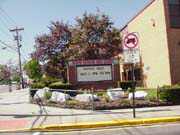As part of President Bush’s grand plan for education reform, the New Jersey State Department of Education sent out an alert to 200 elementary school programs early this month, including North Bergen’s HOPE program for students who are falling behind in their education. The program, which caters to students who have not been able to complete eighth grade and go on to high school, fell under the guidelines as “needing improvement,” according to a new federal program.
Bush’s plan calls for extensive financial support for the schools and districts that fall under these guidelines, but these schools also could be penalized if the new federal standards toward public education are not met.
Because of the classification, the schools included in the list are expected to receive additional funds from the federal government to enhance and improve existing programs.
The regulations are all part of Bush’s “No Child Left Behind Act,” which called for schools to be held to the highest of standards, with the most attention being focused upon reading and mathematics.
North Bergen’s inclusion in the list centers around the district’s HOPE (Helping Overage Pupils Excel) program, which was instituted for teenagers who are at least two years behind students their own age on the educational ladder. The program is held at North Bergen High School.
“It is a disaffected class from those already attending the high school,” Superintendent of Schools Peter Fischbach said last week. “All of the students in the HOPE program were taken out of the elementary schools, and we created a group of classes within the high school in order to help their educational growth.”
There are 39 students who are currently enrolled in the HOPE program, but it is those students’ test scores that have been included in the list of schools “needing improvement” in the eyes of the federal government.
“These are children who came to school and into the educational process with multiple problems,” Fischbach said. “They do have special needs. We know that they are behind just by selection and placement.”
Because of that, Fischbach feels that the classification and tag as “needing improvement” is unfair.
“It’s an unfair comparison to the rest of the district,” Fischbach said. “Unfortunately, these students’ test scores count toward the eighth grade statistics. But the overall district’s numbers are way above the state mandate. Any testing [of] these students will show a negative effect as opposed to the regular student population.”
Nineteen elementary schools in Jersey City, three in Union City and one in West New York were also among the 200 that are “needing improvement.” None of North Bergen’s six other elementary schools were included among the list.
Schools identified as “needing improvement,” are provided additional funds and assistance to get the scores up; however, the schools face the possibility of receiving financial penalties if they don’t show adequate yearly progress. Bush has called for some schools to be shut down if the progress is not met within a four-year time frame.
The basis for the assessment all stems from fourth and eighth grade proficiency tests taken in the calendar year of 2000.
Where is progress made?
One of the toughest portions of the new federal legislation is that the academic progress has to be met according to different standards and averages depending on the race and income. North Bergen has a diverse background in all areas, so it would be extremely difficult to classify the district strictly in one specific social area.
“With the requirement that every group has to show improvement, it has thrown many schools into one category or another,” said David Griffith, a representative for the National Association of State Boards of Education. “It’s made that idea overwhelming to some school districts.”
Fischbach agreed.
“It would be very difficult to include North Bergen with any one set, because we are so diverse with our population,” Fischbach said. “It’s another area where the classification is unfair.”
Some state education administrators are worried that this classification is just the tip of the iceberg. The initial list of 200 schools is expected to “skyrocket,” according to a representative from the state Department of Education.
And the money set aside to act as the additional funding from the federal government is believed to be in the vicinity of $3 million for the entire 200 schools, which roughly comes to $15,000 per school.
There is not much that can be done to make drastic improvements with just $15,000.
“In terms of alternate education, this [HOPE] program is a very expensive program,” Fischbach said. “Getting $15,000 wouldn’t even match the cost to purchase the books for the program. Then, there are materials, computer equipment. It’s just not that much.”
Fischbach understands the goal of the program.
“Any student that gets left behind is a loss,” Fischbach said. “I agree with that. We’ve been working on an educational objective to get these students in the HOPE program to achieve.”
